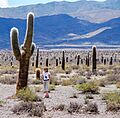National park facts for kids
A national park is a special area of land that a country's government officially protects. These parks are often created to keep wild animals safe and to preserve beautiful natural places. There are thousands of national parks all over the world!
The very first national park was Yellowstone National Park in the United States. It was created in 1872. However, the idea of protecting natural areas came even earlier. An American painter named George Catlin suggested this idea back in the 1830s.
The International Union for the Conservation of Nature (IUCN) is a global group that helps define and protect these areas. They say a national park is a "Category II" type of protected area. The biggest national park that fits this definition is the Northeast Greenland National Park, which was set up in 1974. As of 2010, there were about 7,000 national parks worldwide!
What Makes a National Park?
In 1969, the IUCN explained what makes an area a national park. It should be:
- A fairly large area with one or more natural ecosystems. This means the land, plants, and animals haven't been changed much by humans.
- A place with special plants, animals, geology (rocks and landforms), or habitats. These features should be important for science, education, or just for fun. It might also be a very beautiful natural landscape.
- An area where the country has taken steps to stop people from using or building on the land. They must make sure its natural features are respected.
- A place where visitors can come in, under certain rules. This is for people to learn, get inspired, enjoy the culture, or just relax.
- At least 1,000 hectares (about 2,470 acres) in size, with parts where nature is fully protected.
- Protected by law.
- Given enough money and staff to protect it well.
- A place where natural resources are not used for business, like building dams. Some activities like sport fishing or necessary management are allowed.
While most national parks are managed by their national governments, some are different. For example, in Australia, state governments run national parks. In Japan, some "Quasi-national Parks" are recognized by the government but managed by local governments.
Famous National Parks
Here are some well-known national parks:
- Manú National Park, Peru
- Everglades, Florida, United States
- Hawaii Volcanoes National Park, United States
- Yosemite National Park, California, United States
- Grand Canyon, Arizona, United States
- Yellowstone National Park, United States
- Great Barrier Reef, Queensland, Australia
- Dartmoor, Devon, England
- Galapagos National Park, Ecuador
- Teide National Park, Spain
Images for kids
-
Los Cardones National Park, Argentina
-
Landsat 7 image of Kavir National Park, Iran.
-
Landscapes of the Koli National Park in North Karelia, Finland, have inspired many painters and composers, e.g. Jean Sibelius, Juhani Aho and Eero Järnefelt.
-
Manuel Antonio National Park in Costa Rica was listed by Forbes as one of the world's 12 most beautiful national parks.
-
Beech trees in Mallard Wood, New Forest National Park, Hampshire, England
-
Yosemite Valley, Yosemite National Park, in California, United States
-
Grand Prismatic Spring in Yellowstone National Park, Wyoming, United States; Yellowstone was the first national park in the world.
-
Royal National Park, New South Wales, Australia
-
Lago Covel in the Stelvio National Park, Italy
See also
 In Spanish: Parque nacional para niños
In Spanish: Parque nacional para niños




















